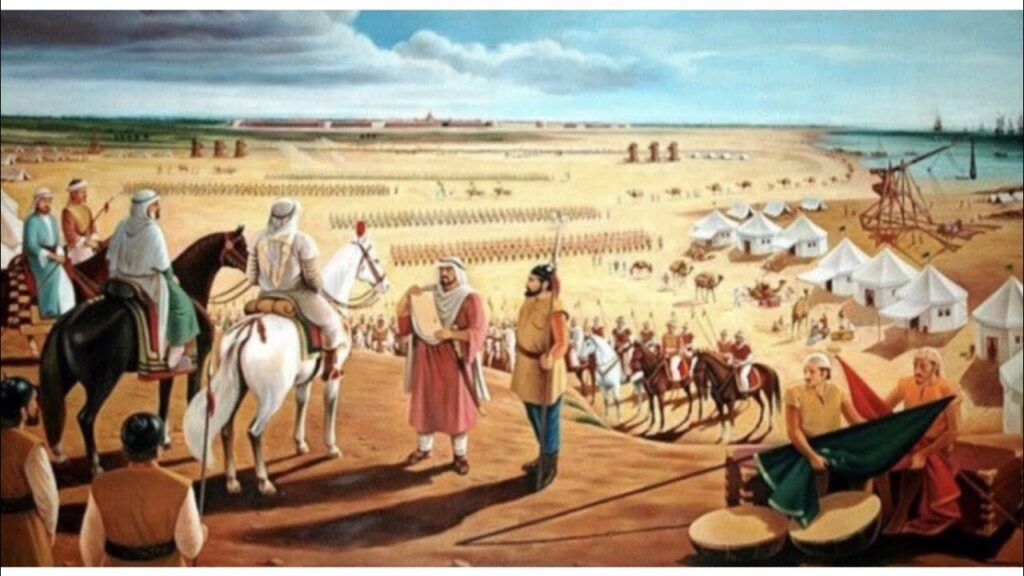Buddhism never fails to profess esoteric concepts like peace, moksha and nirvana, yet they proved to be highly treacherous people in the real world. They never presented a united face with Hindus in dealing with Muslim invaders and, at least in two crucial battles, openly supported Muslim invaders. It is an altogether different matter that they were later butchered by these very same invaders.
Incidentally, both these battles happened in the 8th century. The first one was the battle of Sindh against Hindu King Dahar in 711-12 CE. Hindus ruled Sindh, but the economy was in the hands of Buddhist traders. However, for various reasons, they were unhappy with the Hindus. As soon as Arabs arrived at the doors of the city of Debal (Karachi), they made a beeline toward the Arab camp. Various Buddhist tribes, such as the Meds and Buddhist rulers of neighbouring Nerun, Siwistan, and Kaka Kolak, offered their full-fledged support to Arabs. Qasim offered them substantial benefits and concessions in trade after capturing Sindh. Buddhist traders then spilled all the beans and shared every secret and weakness of the Sindh army.

Qasim laid an elaborate siege on the Debal fort. The Buddhists informed him that the flag fluttering proudly atop the temple was the talisman that protected the fort and he had to bring it down anyhow if he harboured any chance of winning it. Qasim then trained the manjanik (Stone-throwing machine) on the flag and could bring it down after several attempts. Seeing their divine symbol down, the Hindu forces became uncontrolled and disheartened at the bad omen. Utter confusion prevailed in the town. In anguish, the soldiers rushed out of the city and made an unorganized and chaotic attack on the Qasim’s forces. They soon lost the resolve to fight and were slaughtered mercilessly. The fort was captured and the Muslim flag was hoisted for the first time on the soil of Bharatvarsha.
However, Arabs were in no mood to keep their promises and they went on to destroy each and every Buddhist monastery along with Hindu temples in Sindh and Afghanistan.
The next decisive battle was fought between the Tang Chinese and the Arabs at Talas in July 751 CE at the banks of River Talas, which forms the border between present-day Kazakhstan and Kyrgyzstan. The Tang and Abbasid armies met in the valley of the Talas River to assert their control over the Syr Darya region.

For the past many decades, lingering differences with the Chinese made Tibetans a staunch ally of Arabs. There was a history of triangular conflicts between Tangs, Tibetans and Turks, mainly over the Tarim Basin (present Xinjiang under the occupation of China). The surprising factor is that all the three warring parties were Buddhists. Unlike Muslims, every other community gave priority to their internal differences and failed to put up a united front in the face of the external invader. The Basin had Kashgar, one of the most strategically important cities on the Silk Road connecting China, India, the Middle East, and Europe for more than 2,000 years, making it one of the oldest continuously inhabited cities. In 692 CE, Tang Queen Wu took control of the Basin from the Tibetan empire. In those days, Tibet was a significant regional power and it did not take kindly to such expansion. Though divided among various tribes, Turks also made the occasional predatory raids in the Basin. Arabs saw their chance and their commander Qutayba ibn Muslim started making the conquests in the Western part of Central Asia, conquering important towns of Samarkand and Bukhara. Arabs were now in the immediate neighbourhood of Tarim Basin. The three regional powers remained riven by their internecine feuds and impending Arab attacks gave them the opportunity to settle scores.
Arabs, as elsewhere, had their eyes further towards the east and wanted to capture another important town of Fergana. Tibetans became their ally as they wanted to defeat their arch-enemy Tang Chinese. Arabs had an easy victory and the defeated Turkish ruler Ikhshid fled to China in 715 and requested Tangs to help reclaim his throne. Tangs indeed helped him and he could become the king again. Yet again, in 717, during the battle of Aksu, armies of Arabs and Tibetans besieged the oasis town Aksu in the Tarim Basin but ultimately had to face the defeat in front of a stronger Tang army. In 747, Tangs and Tibetans again fought for the Gilgit region of Kashmir, with the Chinese becoming victorious. In 748, another major town Merv, in Central Asia, fell to Arabs. One after another, the major cities were felling to Arabs with demography also changing fast, yet neither Chinese nor Tibetans were bothered. Arabs now aspired for complete control of Central Asia. Their wish would be fulfilled soon in 751 in the battle of Talas.

As happened earlier on multiple occasions, Tibetans were friends with the Arabs. The battle continued for five long days. On the fifth day, at the very last moment, Karluk Turk soldiers switched over to the Arabs to defeat the Chinese. This change of sides reversed the balance of power, resulting in a sudden Tang collapse. Lakhs of Chinese soldiers were killed and 25,000 were captured as slaves. The battle effectively ended the Buddhist presence in Central Asia and paved the way for Islam to take firm roots. However, it took a century for complete Islamification to happen across the region’s deserts, mountains, and steppes. Once Islamised, these very Turks launched ferocious attacks on India in the coming centuries.
China, however, did not allow Muslims to make inroads into their mainland further. They managed to identify their enemy, though a little late. Two massacres happened, which sent a shiver down the spine of Muslims who did not dare to touch the Chinese afterward. The first, Yangzhou massacre occurred in 760 CE when thousands of Muslims were hacked to death. Next, the more violent, Guangzhou massacre happened in 879 CE when an estimated 120,000 Muslims were slaughtered. Talas thus remained the first and last meeting between Arabs and Chinese as things quickly fell into equilibrium.
The battle, however, had another far-reaching effect. Among the prisoners of war were a few skilled Chinese artists too. Through them, Arabs and then the rest of Europe learned the art of paper-making, which until then was a Chinese secret. Soon, a number of paper-making factories sprang up in Samarkand, Cairo, Baghdad, Damascus and Delhi. The Arabs similarly learned the Hindu numerals before spreading them to Europe. The paper-making technology along with our numerals, would one day spawn the Industrial Revolution in Western Europe.
Islam could not have spread without the active connivance of Buddhists in Central Asia and India. However, singling out the Buddhists will be a little unfair as even Christians helped Muslims to defeat their common enemy, Sassanids, when the Arabs made a conquest in Persia in the 630s/640s. There is no doubt that Arabs’ victories were often catalysed by the betrayal of the rival community of the enemy.
Muslim invaders hated Buddhists even more than the Hindus, as the former do not believe in the concept of God. At the turn of the 12th century, Bakhtiyar Khilji attacked Nalanda University and killed every single monk there. At one estimate, the sacking of Nalanda destroyed numerous knowledge systems of India, pushing it backward by centuries. Fearful, the rest of the Buddhists fled to Tibet, Bhutan and Burma. Not a single one took up the sword, though.
The decline of Buddhism in India started with its growing esotericism and detachment from the public by the 5th century. With a rise in the Bhakti cult, Hinduism began to stress the concept of love, devotion and salvation, the very ideas copyrighted by Buddhism, making the latter redundant. In 515, Mihirkula, the Alchon Hun, destroyed more than 1600 Buddhist monasteries and stupas, sending them on an accelerated decline. The betrayal at Sindh made them almost a pariah as their patronage by Hindu kings stopped. Turks then dealt a final nail in the coffin of Buddhism in India, though a few centuries back, they themselves were Buddhists.
On October 14, 1956, BR Ambedkar, with 3,65,000 of his Dalit supporters, made history by converting to Buddhism to protest against the debilitating caste system. Earlier, he even toyed with the idea of converting to Islam and Zoroastrianism, but he found Islam too violent and the Parsis rejected him. Finally, better sense prevailed, but it would take time to heal the old wounds of centuries. Indians do have a history of not recognising their true enemies and these neo-Buddhists are no different. Hence, unmindful of the repercussions of their earlier botched adventures, Buddhists keep supporting Abrahamics in India, just to spite Hindus.
Source: 1. RC Majumdar, The History and Culture of the Indian People: Vol. 3 — The Classical Age
2. Bai, Shouyi (2003). A History of Chinese Muslim (Vol.2).
3. Lars Fogelin, An Archaeological History of Indian Buddhism
4. André Wink, Al-Hind: The Slavic Kings and the Islamic conquest, 11th-13th centuries
Written by Amit Agarwal, author of the bestseller on Indian history titled “Swift horses Sharp Swords”. You may buy the book at the following link:
https://www.amazon.in/dp/9355788266 (Hindi)

Twitter handle @amit1119 Instagram/ Facebook – amitagarwalauthor
Featured image sourced from internet.
![]()
- How Hindu rituals spawned numerous advancements in science, maths and other arts - March 13, 2024
- Naga Sadhus and their fighting skills - February 20, 2024
- Lessons for India from the Israel-Palestine conflict - October 12, 2023

